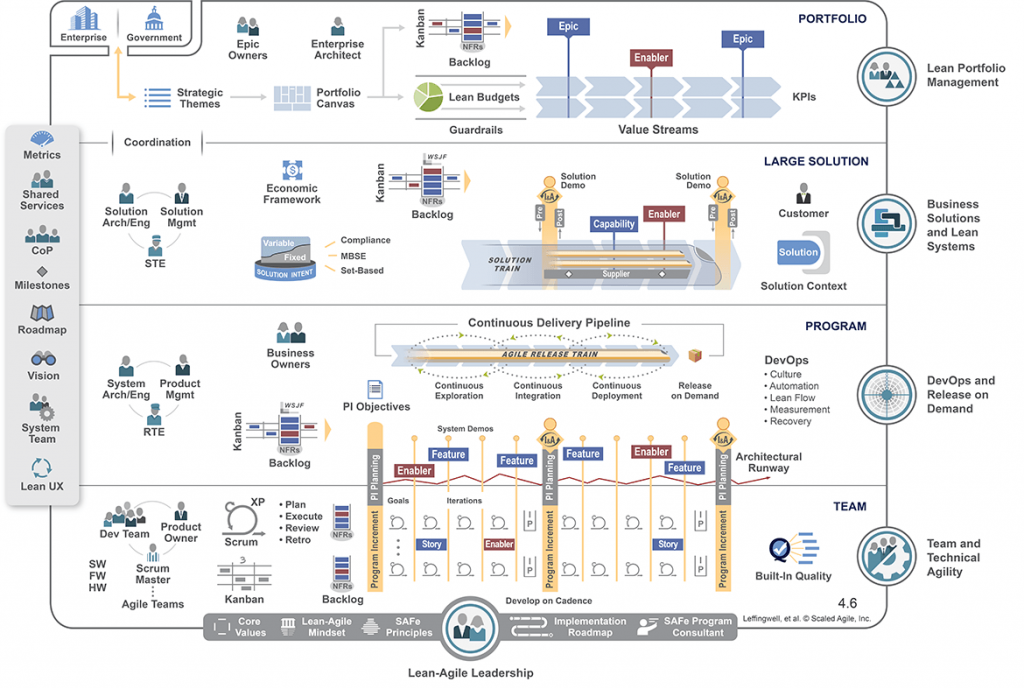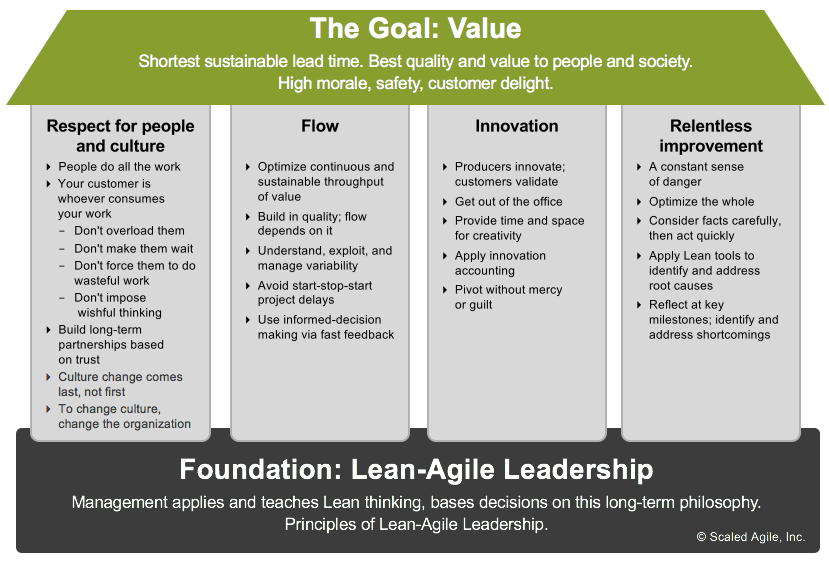Nowadays, a lot of postings are going around in social media asking “I SAFe Agile?”, or telling “SAFe is not Agile!”.

So, I was asking myself: Is SAFe Agile? Here, I want to share my answer with you.
First, when I’m talking about SAFe, I mean the “Scaled Agile Framework“. Be careful when you visit their website. The picture’s you see first called Essential, Large Solution, Portfolio or Full SAFe are not the SAFe framework. They are an index for the website. If you discover the picture with your mouse, you’ll see that there are hyperlinks behind every little piece of the picture. If you click thru them, you’ll learn that there is a lot of documentation behind, and also references to third party documentation and books. It’s important to know that. When talking about the SAFe Framework, this means the whole body of knowledge, not the nice index graphic on the website.
The next question to answer: What is Agile? Before I can answer the question “Is SAFe Agile?”, I need to define “Agile” in the context. As there is no official definition, I’ll take the “Sit, Crawl, Walk, Run and Fly” approach. If a framework, body of knowledge or anything else you use well help you, a team or an enterprise to raise their maturity in agility and having steps and guardrails built in to do so – I would call it Agile.
As a next step, I will list some SAFe basic, feel free to assess at the end if SAFe is Agile or not (when writing this post, SAFe 4.6 is official and SAFe 5 is in preview, but the changes will not affect your assessment).
Agile Manifesto
The base of SAFe is the “Manifesto for Agile Software Development“. If you did not hear about or read it so far, you should really read and try to understand it. It is the base for many great things like Scrum or SAFe.
We are uncovering better ways of developing software by doing it and helping others do it. Through this work we have come to value:
Manifesto for Agile Software Development
– Individuals and interactions over processes and tools.
– Working software over comprehensive documentation.
– Customer collaboration over contract negotiation.
– Responding to change over following a plan.
That is, while there is value in the items on the right, we value the items on the left more.
Also, there are twelve principles defined in this manifesto – and SAFe is based on that. If it does not match, it’s not SAFe.
Our highest priority is to satisfy the customer through early and continuous delivery of valuable software.
Welcome to changing requirements, even late in development. Agile processes harness change for the customer’s competitive advantage.
Deliver working software frequently, from a couple of weeks to a couple of months, with a preference to the shorter timescale.
Business people and developers must work together daily throughout the project.
Build projects around motivated individuals. Give them the environment and support they need, and trust them to get the job done.
The most efficient and effective method of conveying information to and within a development team is face-to-face conversation.
Working software is the primary measure of progress.
Agile processes promote sustainable development. The sponsors, developers, and users should be able to maintain a constant pace indefinitely.
Continuous attention to technical excellence and good design enhances agility.
Simplicity – the art of maximizing the amount of work not done – is essential.
The best architectures, requirements, and designs emerge from self-organizing teams.
At regular intervals, the team reflects on how to become more effective, then tunes and adjusts its behavior accordingly.
https://agilemanifesto.org/principles.html
SAFe refers the Manifesto, e.g. https://www.scaledagileframework.com/lean-agile-mindset/. Also, it is a fixed component in the trainings.
SAFe Core Values

SAFe extends the Manifesto with four Core Values:
- Alignment
- Built-in Quality
- Transparency
- Program Execution
These are not buzz-words. Just read the documentation. E.g the Built-in Quality is split in five primary dimensions: Flow, Architecture & Design Quality, Code Quality, System Quality and Release Quality. If you go i.g. through SAFe DevOps certification, you’ll learn more about this.
Also, SAFe requires Lean-Agile Leadership. Without Lean-Agile Leadership, the Core Values will not happen.
See https://www.scaledagileframework.com/safe-core-values/ for more details.
SAFe Principles

SAFe extends the Agile Manifesto Principles with another nine SAFe Principles:
#1 – Take an economic view
#2- Apply systems thinking
#3- Assume variability; preserve options
#4- Build incrementally with fast, integrated learning cycle
#5- Base milestones on objective evaluation of working systems
#6- Visual and limit WIP, reduce batch sizes and manage queue lengths
#7- Apply cadence, synchronize with cross-domain planning
#8- Unlock the intrinsic motivation of knowledge workers
#9- Decentralize decision-making
As SAFe is for scaling, having a focus on teams starting with about 40 up to thousands of persons, there are principles for scaling needed. If you have e.g. a deeper look at #5, #7 and #9, you’ll see the sense.
In SAFe 5, there is a #10 “Organize around value“. It is not really new, it was also included in several chapters in 4.6, but not as an explicit principle.
Lean-Agile Mindset

In SAFe, a Lean-Agile Mindset is explicitly needed. The base for this is the primary bodies of knowledge of Agile development, Lean Product development and systems thinking; and also the two primary aspects Thinking Lean and Embracing agility.
The SAFe House of Lean is a good Big Picture for that.
Having a foundation with Lean-Agile Leadership, bring the highest Value with the four pillars: Respect for people and culture, Flow, Innovation, Relentless improvement.
Again here, the changes here in SAFe 5.0 Lean-Agile Mindset will not change your decision.
Lean-Agile Leadership

A lot of Scrums Masters know how painful it is to be a servant leader not having an agile management around.
To be SAFe, having Lean-Agile Leadership not just having the knowledge, but also supporting the growth of Agile maturity.
It’s not enough that management commit themselves to quality and productivity, they must know what it is they must do. Such a responsibility cannot be delegated.
W. Edwards Deming
Not having a Lean-Agile Leadership can lead to something often called “Waterfall/Agile Hybrid”. Personally, I’m not a good friend of an “Hybrid”. A Hybrid is a Hybrid is a Hybrid – but not Agile in my opinion. And if it is Agile, it is not a Hybrid anymore, but Agile.
At last: Is this SAFe Agile?
To decide if SAFe is Agile, I think the best way is to look for a Company doing SAFe (doing, not calling), have a look and decide.
So – if someone says “we are doing SAFe”, have a look if they at least fulfill all of
- Agile Manifesto values and principles
- SAFe Core Values
- SAFe Principles
- Lean-Agile Mindset
- Lean-Agile Leadership
If not, also double-check if they just started with the maturity of “Sit”, and they are on a good way to ” Crawl, Walk, Run and Fly ” later. And read also all the rest of relevant information about SAFe you need to decide if they do SAFe, or they are on a good way to do so in the future.
If not, they are not doing SAFe. So this particular example will not help you to decide.
If yes, this is a good example to decide if what you are seeing Agile or not.

